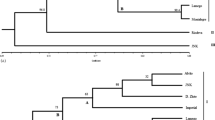Abstract
Isozymes and random amplified polymorphic DNA (RAPD) markers were used for precocious identification of non-maternal plants in progenies of the facultative apomict Poa pratensis. Four progenies obtained from controlled crosses that showed different degrees of apomixis on isozyme analysis of phospho-gluco-isomerases, esterases and peroxidases were chosen for RAPD analysis to generate genomic fingerprints using species-specific primers. At an advanced vegetative stage, a morphological analysis was also performed and characteristics related to growth habit and leaf morphology were observed and recorded. On the basis of the isozyme and RAPD electrophoretic pattern and the morphological appearance, each plant was classified as maternal or aberrant. All three classes of genetic markers employed were able to identify plants that exhibited aberrant traits in the four progenies. Overall, the results of RAPD analysis supported those of isozyme and morphology studies. However, in each progeny, some plants which both isozyme and morphological analyses distinguished as of maternal origin were aberrant according to RAPD analysis. Therefore, the RAPD method proved the most precise screening technique. The greater cost of the molecular approach was offset by its higher accuracy. The use of either three isozyme systems or six primers for PCR amplification seems to be sufficient for reliable estimation of the degree of apomixis. Histological analyses were carried out and the aposporic development of the plant material studied.
Similar content being viewed by others
References
Barcaccia G (1994) Development, comparability and potential applications of RAPD markers in the genus Medicago. J Genet Breed 48:161–167
Bashaw EC, Funk RC (1987) Apomictic grasses. In: Fehr WR (ed) Principles of cultivar development (crop species, vol 2) Macmillan, London, pp 40–82
Clausen J (1954) Partial apomixis as an equilibrium system in evolution. Caryologia [Suppl] 6:469–479
Edwards K, Johnstone C, Thompson C (1991) A simple and rapid method for the preparation of plant genomic DNA for PCR analysis. Nucleic Acids Res 19:1349
Grazi F, Umaerus M, Åkerberg E (1961) Observations on the mode of reproduction and embryology of Poa pratensis. Hereditas 47:489–541
Huff DR, Bara JM (1993) Determining genetic origins of aberrant progeny from facultative apomictic Kentucky bluegrass using a combination of flow cytometry and silver-stained RAPD markers. Theor Appl Genet 87:201–208
Marshall DR, Brown AHD (1974) Estimation of the level of apomixis in plant populations. Heredity 32:321–333
Mazzucato A (1995a) Italian germplasm of Poa pratensis L. I. Variability and mode of reproduction. J Genet Breed (in press)
Mazzucato A (1995b) Italian germplasm of Poa pratensis L. II. Isozyme progeny test to characterize genotypes contrasting for the mode of reproduction. J Genet Breed (in press)
Naumova T, Nijs APM den, Willemse MTM (1993) Quantitative analysis of aposporous parthenogenesis in Poa pratensis genotypes. Acta Bot Neerl 42:299–312
Nijs APM den (1990) Experimenting with apomixis and sexuality in Poa pratensis. Apomixis Newslett 2:52–54
Nijs APM den, Winkelhorst G (1992) Apomixis: a mixed blessing to the breeder of polyploid Poa pratensis. In: Veronesi F, Bullitta S, Caredda S (eds) Ploidy and chromosome manipulations in forage breeding. Proc 17th EUCARPIA Fodder Crop Section Meeting, Alghero, Italy, pp 45–52
Nogler GA (1984) Gametophytic apomixis. In: Johri BM (ed) Embryology of angiosperms. Springer, Berlin Heidelberg New York, pp 475–518
Ozias-Akins P, Lubbers EL, Hanna WW, McNay JW (1993) Transmission of the apomictic mode of reproduction in Pennisetum: co-inheritance of the trait and molecular markers. Theor Appl Genet 85:632–638
Spoor W, Hay JM (1979) Identification of Poa pratensis lines using electrophoresis of seed extracts. Seed Sci Technol 7:467–474
Weeden NF, Emmo AC (1985) Isozyme characterization of Kentucky bluegrass cultivars. Can J Plant Sci 64:985–994
Williams JGK, Kubelik AR, Livak KJ, Raflski JA, Tingey SV (1990) DNA polymorphisms amplified by arbitrary primers are useful as genetic markers. Nucleic Acids Res 22:6531–6535
Wu L, Jampates R (1986) Chromosome number and isozyme variation in Kentucky bluegrass cultivars and plants regenerated from tissue culture. Cytologia 51:125–132
Author information
Authors and Affiliations
Rights and permissions
About this article
Cite this article
Mazzucato, A., Barcaccia, G., Pezzotti, M. et al. Biochemical and molecular markers for investigating the mode of reproduction in the facultative apomict Poa pratensis L.. Sexual Plant Reprod 8, 133–138 (1995). https://doi.org/10.1007/BF00242256
Received:
Accepted:
Issue Date:
DOI: https://doi.org/10.1007/BF00242256




